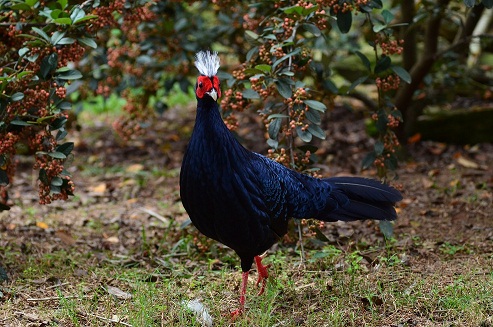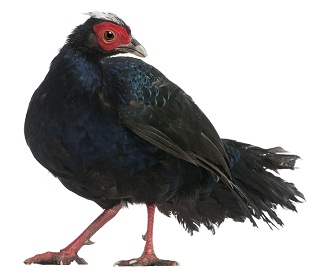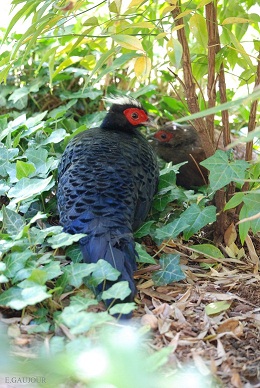 Edwards’s Pheasant (Lophura edwardsi) | By Don Butler
Edwards’s Pheasant (Lophura edwardsi) | By Don Butler
The white framed faces of the Red-shanked Douc monkeys look out from the canopy of Khe Nuoc Trong forests in Le Thuy district, Quang Binh province. In the distance, the calls of White-cheeked Gibbons echo through the early morning stillness. Browsing in the shadows of the forest floor are Giant and Annamite muntjac, and perhaps Saola, only discovered by science in the 1990s. These and many other rare and endangered species can be found in this forest, a jewel of bio-diversity in one of the most bio-diverse regions on the planet.
But Ke Nuoc Trong is not a pristine paradise. An important part of the forest’s biological heritage is missing: Edward’s Pheasant, once found only in the lowland forests of Central Vietnam, has not been seen in the wild since 2000.
This beautiful bird, whose males are iridescent blue with a flash of red on the face and a white crest, was discovered in 1896 and recorded by French ornithologists in the 1920s and early 1930s. It then went unrecorded for almost 60 years until 1996. Sadly, not long after being rediscovered, it vanished again. Extensive surveys of its favored haunts have found no trace of it.
 Edwards’s Pheasant at Mulhouse Zoo, France | By Eric Isselee
Edwards’s Pheasant at Mulhouse Zoo, France | By Eric Isselee
The centre of this species’s historic homeland lay in Quang Tri province, the site of the Demilitarized Zone during the American War, which suffered the fiercest fighting and the most aggressive use of herbicides. During this conflict, which ended in 1975, 72 million litters of herbicides, including the infamous ‘agent orange’, were sprayed on forests and fields.
Since then, increasing human populations and demand for agricultural land have further reduced any habitat suitable for Edward’s pheasant. Some forests look intact with regrown or replanted trees but are devoid of animals because they have been hunted for food or illegal trade. Populations of Edwards’s pheasant were reduced, fragmented and left fragile. Snares set for bush-meat may have caught the last individuals, causing this species to go extinct in the wild.
However, there is good news. Sometime in the 1920s, at least 14 pairs of Edwards’s Pheasant were captured and sent to France. This small, exiled population has done well. There are currently over 1000 birds in collections across the world, including birds in the Hanoi zoo. Some may not be purebred Edwards’s Pheasant but genetic analysis is currently underway to find the best genetic stock. The plan is to select the range. It will take at least five to seven years but, if successful, these birds could be released back into the wild. Of course, the wild bird must be ready to receive them. Efforts are being made to locate any remaining populations of Edwards’s Pheasants in pockets of suitable habitat within larger blocks of forest. Measures are being implemented to restore and safeguard other potential pheasant habitats. One of the greatest threats to the success of a reintroduction program would be hunting, so Viet Nature Conservation centre (Viet Nature), together with their partners, are aiming to eradicate hunting at key sites: Ke Nuoc Trong, Bac Huong Hoa, Dakrong, Phong Dien and Ke Go Nature Reservers.
The first steps towards establishing an Edwards’s pheasant breeding program have already been taken. With the support of local and international partners, Viet Nature will build a breeding station and environmental education centre on five hectares of land in Quang Binh province (outside any reserve for biosecurity reasons).
Right now the Edwards’s pheasant ex-situ conservation community, including staff at Hanoi Zoo, and zoos and private breeders in Europe, are selecting the best birds for the breeding program. Four birds were sent to Hanoi Zoo in 2015 to breed with descendants of the only wild male caught in 1997.
 Edward Pheasant at Lyon zoo, France | By Emmanuelle Gaujour
Edward Pheasant at Lyon zoo, France | By Emmanuelle Gaujour
Establishing a viable breeding group of Edwards’s pheasant is just the first step. Release into the wild will take more time, trial and error. in the spring of 2017, the Year of the Rooster, the first aviaries with a few pairs of Edwards’s pheasant will be built at the breeding station. It’s hoped that by the next year of the Rooter, sustainable population of Edwards’s pheasant may be found in the wild in its homeland.
At the core of these efforts to return once species of bird to its natural home is the restoration of Vietnam’s forests. Forests provide the basics of life – clean air and clean water. They are a buffer against the threat of climate change. For Vietnamese people forests are something more: they signify the survival of the unique beauty of Vietnam’s landscapes and culture. What better symbol of that survival than this beautiful bird, its feathers flashing in the dappled light, rejoicing in the life-giving rain?
Source: Viet Nature Conservation centre (May 2017) The Edwards’s Pheasant Heritage (Vietnam airlines inflight magazine)
